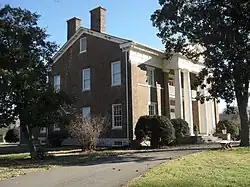Tulip Grove
Tulip Grove is an antebellum house built in 1836 for Andrew Jackson Donelson, who was the nephew of Andrew Jackson.[2] The site was listed on the National Register of Historic Places in 1970.[1]
Tulip Grove | |
 | |
 | |
| Location | Lebanon Rd, Hermitage, Tennessee |
|---|---|
| Coordinates | 36°12′44.43″N 86°36′11.33″W |
| Area | 10 acres (4.0 ha) |
| Built | 1836 |
| Architect | William C. Hume, Joseph Rieff |
| Architectural style | Greek Revival |
| NRHP reference No. | 70000607[1] |
| Added to NRHP | February 26, 1970 |
History
While Andrew Jackson was still president in 1834, Andrew Jackson Donelson decided to build Tulip Grove on land near the Hermitage. He enlisted Nashville master builders William C. Hume and Joseph Reiff, who were working on rebuilding the Hermitage mansion after a fire, to undertake the construction.[3][4]
The house was completed in 1836 with the original name of "Poplar Grove." Former president Martin Van Buren allegedly suggested Donelson rename it Tulip Grove during a visit in 1842.[3]
In April 1858, Donelson sold the property to wool producer Mark R. Cockrill.[5] Other owners included Thomas O. Treanor and Mary Andrews Treanor, whose daughter, the painter Mayna Treanor Avent (1868–1959), was born there.[6]
Lawsuit
In 1914, Charles Buntin and Jane Berry Buntin purchased the home and surrounding property. On March 11, 1964, Jane Buntin deeded the mansion and 26.33 acres surrounding it to the Ladies' Hermitage Association (LHA), now known as the Andrew Jackson Foundation. In return, the LHA agreed to pay Buntin, "her heirs and assigns, for a period of ninety-nine (99) years from and after March 1, 1964 one-third (1/3) of all gate receipts received by Grantee from visitors to Tulip Grove House located on said land, which payments are to be made on a monthly basis."[7]
From 1965 to 2001, the LHA paid the Buntin family over $300,000 from ticket sales. In 2001, the LHA discontinued the tours, citing their lack of profitability, and began using Tulip Grove as an event space. This change resulted in the Buntin family receiving a $1,200 annual payment instead of a portion of ticket sales. In 2007, members of the Buntin family filed suit against the LHA for breach of contract.[7]
In 2012, the Tennessee Court of Appeals upheld a lower court ruling that the LHA had not breached the contract, but it also ruled that the Buntin family was due a portion of revenue generated by special events held at Tulip Grove.[7]
Architecture
Tulip Grove is representative of the antebellum Greek Revival style that was popular before the American Civil War. It consists of two main stories, a basement, and an attic.[8]
Tulip Grove Gallery
 Exterior rear view
Exterior rear view Exterior side view
Exterior side view Front closeup
Front closeup Exterior Descriptive Signboard
Exterior Descriptive Signboard Interview dining room window
Interview dining room window Interior view of plantation office through window
Interior view of plantation office through window Parlor
Parlor Interior stairwell
Interior stairwell Kitchen view from dining room
Kitchen view from dining room Parlor fireplace
Parlor fireplace
References
- "National Register Information System". National Register of Historic Places. National Park Service. March 13, 2009.
- The Hermitage, p. 33, Published by the Ladies' Hermitage Association, 1997
- "Tulip Grove | Andrew Jackson's Hermitage Mansion". The Hermitage. Retrieved 2023-02-25.
- "The Hermitage Mansion". SAH ARCHIPEDIA. 2018-07-17. Retrieved 2023-02-25.
- Cheathem, Mark R. (2007). Old Hickory's Nephew: The Political and Private Struggles of Andrew Jackson Donelson. LSU Press. p. 309. ISBN 978-0-8071-3565-5.
- "Tennessee Portrait Project". Archived from the original on 2018-06-24. Retrieved 2014-01-06.
- "Field v. Ladies' Hermitage Ass'n, No. M2013-02635-COA-R3-CV | Tenn. Ct. App., Judgment, Law". Retrieved 2023-02-25.
- Center for Historic Preservation, Middle Tennessee State University (1983). Tulip Grove: Historic Structure Report.